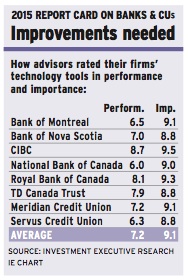
Financial advisors who ply their trade with Canada’s banks and credit unions would like nothing more than for their firms to improve the technology they put in place for advisors. That’s because advisors cited problems with outdated hardware and operating systems, multiple systems that aren’t integrated with each other, inaccuracies and slow networks.
This malaise regarding technology is most evident in the difference between the overall average importance rating (9.1) and the overall average performance rating (7.2) that advisors gave the “technology tools and advisor desktop” category. The “satisfaction gap” of 1.9 points is the widest gap in the Report Card, and advisors said their firms need to provide tools and streamlined desktop systems to make advisors’ jobs easier and more efficient.
Some firms, such as Canadian Imperial Bank of Commerce (CIBC) and Royal Bank of Canada (RBC), both based in Toronto, have made strides to improve the technology they make available – and advisors with these banks recognized their firms’ efforts.
Other firms, such as Montreal-based National Bank of Canada and Toronto-based Bank of Nova Scotia, saw their ratings bounce back after poor showings last year, but still have much room for improvement.
For example, National Bank’s technology rating rose to 6.0 from 5.4 year-over-year, but still represented the lowest technology rating in this year’s Report Card. In particular, advisors noted their “outdated” and “antiquated” tools – and the sheer number of systems and platforms advisors need to log into just to assess their clients’ needs.
“When you want to know your clients’ assets, you have to go to six or seven different platforms,” says a National Bank advisor in Quebec.
Adds a colleague in Ontario: “Compared with other institutions, we’re behind – although we’re making progress. Our systems should be all in one. Right now, we have to access several systems just to get a full picture of our clients’ financial states.”
National Bank recently took the “first step in the harmonization of platforms,” says Annamaria Testani, vice president of national sales. However, she points out: “You have to put it in perspective” because one of the major challenges of such an initiative is balancing privacy protection and convenience, which often are at odds.
Meanwhile, advisors with Edmonton-based Servus Credit Union were bogged down by delays and “holes” their various technology systems throughout much of the past year. That’s why they gave their firm the second-lowest rating in the technology category, at 6.3.
But Servus’ senior management is aware of the issues and is looking to address them with Vancouver-based Credential Financial Inc., which provides dealer services to partner credit unions, says Randy Biberdorf, Servus’ vice president, wealth management.
“We’re working on a project with [Credential] to add quite a bit more functionality at the start of the sales process because, right now, it’s a bit disjointed,” he says. “Things don’t flow as well as they should, and so there’s quite a few enhancements that are planned to streamline that.”
One firm that already invested in streamlining its technology – and saw its efforts pay off among advisors – is CIBC, which earned the highest rating in the technology category, at 8.7, up from 7.8 in 2014.
Many CIBC advisors referred to the bank’s COMPASS platform, an “all new front-end and back-end order-entry system” that pulls data directly from the customer relationship management software to make things faster, says Larry Tomei, CIBC’s senior vice president, national sales and service, retail and business banking. “I’m glad our advisors are talking about it because we really believe we’ve leapfrogged the competition with this new platform.”
“We have COMPASS now, and it streamlines the whole interview process [between advisors and clients]. It gathers all of the information,” says a CIBC advisor in Ontario.
RBC also has focused on making improvements to its technology platform. The bank has emphasized on rolling out electronic signatures over the past couple of years, as well as increased efforts to make Wi-Fi more accessible throughout the branch network.
“We have everything,” says an RBC advisor on the Prairies, “E-signatures, the phone system is new and we can get most things done electronically.”
Having a technology strategy is “fundamental,” says Michael Walker, vice president and head of branch investments with RBC, adding that RBC has made “significant investments” in this area.
Much of these investments has gone into developing and providing “intuitive tools for our advisors to deal with clients,” he adds. In particular, RBC is putting a lot of time into ensuring advisors have a “stable connection,” so that systems don’t crash, which was one of the few complaints RBC advisors had this year.
At Scotiabank, which historically has disappointed its advisors with its technology efforts, there have been initiatives to improve underlying infrastructure and increase the speed of the various systems. Scotiabank advisors noted that their technology tools still are slow and inefficient while the upgrades are rolling out, but some advisors were optimistic things will change when the upgrades are complete.
In fact, a Scotiabank advisor in British Columbia says, the bank is “doing a big tech upgrade, so I’m anticipating some improvement.”
Specifically, Scotiabank is “refreshing hardware, software and networks for our advisors across the entire network,” says Robert MacLachlan, the bank’s managing director, wealth-management business solutions technology.
© 2015 Investment Executive. All rights reserved.